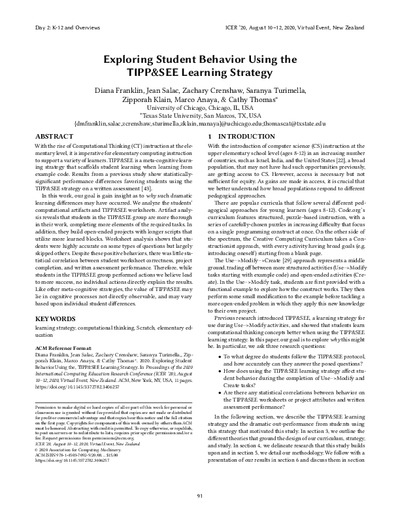Exploring Student Behavior Using the TIPP&SEE Learning StrategyDiana Franklin, Jean Salac, Zachary Crenshaw, Saranya Turimella, Zipporah Klain, Marco Anaya, Cathy Thomas
Publikationsdatum:
Zu finden in: ICER 2020 (Seite 91 bis 101), 2020
|
 |
 Diese Seite wurde seit 3 Jahren inhaltlich nicht mehr aktualisiert.
Unter Umständen ist sie nicht mehr aktuell.
Diese Seite wurde seit 3 Jahren inhaltlich nicht mehr aktualisiert.
Unter Umständen ist sie nicht mehr aktuell.
 Zusammenfassungen
Zusammenfassungen
With the rise of Computational Thinking (CT) instruction at the elementary level, it is imperative for elementary computing instruction to support a variety of learners. TIPP&SEE is a meta-cognitive learning strategy that scaffolds student learning when learning from example code. Results from a previous study show statistically-significant performance differences favoring students using the TIPP&SEE strategy on a written assessment. In this work, our goal is gain insight as to it why such dramatic learning differences may have occurred. We analyze the students' computational artifacts and TIPP&SEE worksheets. Artifact analysis reveals that students in the TIPP&SEE group are more thorough in their work, completing more elements of the required tasks. In addition, they build open-ended projects with longer scripts that utilize more learned blocks. Worksheet analysis shows that students were highly accurate on some types of questions but largely skipped others. Despite these positive behaviors, there was little statistical correlation between student worksheet correctness, project completion, and written assessment performance. Therefore, while students in the TIPP&SEE group performed actions we believe lead to more success, no individual actions directly explain the results. Like other meta-cognitive strategies, the value of TIPP&SEE may lie in cognitive processes not directly observable, and may vary based upon individual student differences.
 Dieses Konferenz-Paper erwähnt ...
Dieses Konferenz-Paper erwähnt ...
 Personen KB IB clear | T. Andrew Binkowski , Tiffany Barnes , Ashok R. Basawapatna , Danielle Boulden , Dolly Bounajim , Dennis J. Bouvier , Danielle Boyd Harlow , Quinn Burke , Veronica Cateté , Yihuan Dong , Hilary A. Dwyer , Barbara J. Ericson , Diana Franklin , Ursula Fuller , Alexandria K. Hansen , Eric R. Hansen , Jennifer Houchins , Amy Isvik , Colin G. Johnson , Yasmin B. Kafai , Maria Kallia , Ami J. Ko , Kyu Han Koh , Yifat Ben-David Kolikant , Michael J. Lee , Gary Lewandowski , Nicholas Lytle , John H. Maloney , Robert McCartney , Tom McKlin , Alexandra Milliken , Cheryl Moran , Hilarie Nickerson , Kylie A. Peppler , Alexander Repenning , Mitchel Resnick , Kathryn M. Rich , Natalie Rusk , Jean Salac , Kate Sanders , Cynthia C. Selby , Sue Sentance , Beth Simon , Carla Strickland , Lew Semjonowitsch Vygotsky , Jane Waite , David C. Webb , Eric N. Wiebe | |||||||||||||||||||||||||||||||||||||||||||||||||||||||||||||||||||||||||||||||||||||||||||||||||||||||||||||||||||||||||||||||||||||||||||||||||||||||||
 Begriffe KB IB clear | computational thinkingcomputational thinking
,  Lernen Lernen learning
, learning
,  Statistik Statistik statistics statistics
| |||||||||||||||||||||||||||||||||||||||||||||||||||||||||||||||||||||||||||||||||||||||||||||||||||||||||||||||||||||||||||||||||||||||||||||||||||||||||
 Bücher |
| |||||||||||||||||||||||||||||||||||||||||||||||||||||||||||||||||||||||||||||||||||||||||||||||||||||||||||||||||||||||||||||||||||||||||||||||||||||||||
 Texte |
|
 Zitationsgraph
Zitationsgraph
 Zitationsgraph (Beta-Test mit vis.js)
Zitationsgraph (Beta-Test mit vis.js)
 Zeitleiste
Zeitleiste
 Anderswo finden
Anderswo finden
 Volltext dieses Dokuments
Volltext dieses Dokuments
 |  Exploring Student Behavior Using the TIPP&SEE Learning Strategy: Fulltext at the ACM Digital Library ( Exploring Student Behavior Using the TIPP&SEE Learning Strategy: Fulltext at the ACM Digital Library ( : :  , 3512 kByte; , 3512 kByte;  : :  ) ) |
 Anderswo suchen
Anderswo suchen 
 Beat und dieses Konferenz-Paper
Beat und dieses Konferenz-Paper
Beat hat Dieses Konferenz-Paper während seiner Zeit am Institut für Medien und Schule (IMS) ins Biblionetz aufgenommen. Er hat Dieses Konferenz-Paper einmalig erfasst und bisher nicht mehr bearbeitet. Beat besitzt kein physisches, aber ein digitales Exemplar. Eine digitale Version ist auf dem Internet verfügbar (s.o.). Es gibt bisher nur wenige Objekte im Biblionetz, die dieses Werk zitieren.









 Biblionetz-History
Biblionetz-History